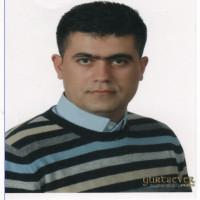Research Article
Review
Issue Editorial Board

https://www.researchgate.net/profile/Ilknur-Alibas?ev=hdr_xprf







Issue Reviewers





Tarım makineleri, Tarım işletmeciliği ve Tarımda ve enerji kullanımları hakkında çalışmalar yürütmektedir.



Aim & Scope
Journal of Agricultural Machinery Science aims to publish research/compilation articles that were realized with interdisciplinary approaches which comply with academic standards and cover the subjects of agriculture, agricultural machinery, energy and technology after they were supported with detailed pre-examination and scientific review process to make them available for accessing of international researchers.
The Journal of Agricultural Machinery Science in accordance with its publication policy publishes the articles that fall within the scope of the fields listed as below:
• Latest Developments in Agricultural Machinery
• Developments in Tractors and System Vehicles
• Soil Tillage, Sowing-Planting-Fertilization, Plant Protection, Harvest-Threshing Technologies
• Irrigation Technologies
• Mechanization in Animal Production
• Precision Agricultural Technologies
• Innovations in Detection and Control Systems
• Postharvest Processes
• System Optimization Techniques and Applications
• Recent Developments in Agricultural Mechanization Planning and Management
• Thermal Engines and Fuel Technologies
• Agricultural Waste Management
• Agricultural Product Processing Technologies
• Renewable and New Energy Sources in Agriculture
• Efficient Using of Energy Resources in Agriculture
Author Guidelines
Tarım Makinaları Bilimi Dergisi Yayın İlkeleri
Tarım Makinaları Bilimi Dergisi yılda 3 kez yayınlanan hakemli bir dergidir. Sunulu veya poster bildiri dışında daha önce hiçbir yerde yayınlanmamış olan tarım, tarım makinaları, enerji ve teknoloji konularını kapsayan araştırma makaleleri ve derleme makalesi tarzı bilimsel çalışmalar değerlendirilip yayınlanmaktadır. Hazırlanmış olan çalışmalar Türkçe ya da İngilizce olarak kabul edilmektedir.
Hakem Önerisi
Dergimizde kayıt sırasında yazarlardan hakem önerisi alınmaktadır. Ancak bu durum, incelemenin önerilen hakemler tarafından yapılacağı anlamına gelmemektedir. Hakem önerilerinizde aynı kurumda çalışmıyor olmak, danışmanlık ve diğer çıkar ilişkisinin bulunmaması gibi etik ilkeleri gözetmenizi rica ederiz.
1- Yazım Kuralları ve Şablonlar
a) Dergiye sunulacak yayın şablonu, yazım kuralları ve yayın hakları devir sözleşmesi
Kabul öncesinde hazırlanması gereken ön başvuru şablonları aşağıdadır. (Dergimizde kör hakemlik uygulaması olduğundan dolayı kabul öncesi başvuru dosyasında yazar isimleri belirtilmemelidir.)
Araştırma Makalesi Şablonları
Türkçe, Araştırma Makalesi Kabul Öncesi Şablonu
İngilizce, Araştırma Makalasi Kabul Öncesi Şablonu
Derleme Makalesi Şablonları
Türkçe, Derleme Makalesi Kabul Öncesi Şablonu
İngilizce, Derleme Makalesi Kabul Öncesi Şablonu
Yayın Hakkı Devir Sözleşmesi (Türkçe) için tıklayınız. (Yayın kaydını yaparken sözleşmeyi eklemeyi unutmayınız)
Copyright Transfer Form(English) Click to Download.
b) Yayının hakem süreci sonrasında kullanılacak şablonlar
Araştırma Makalesi Şablonları
Türkçe, Araştırma Makalesi Şablonu
İngilizce, Araştırma Makalasi Şablonu
Derleme Makalesi Şablonları
Türkçe, Derleme Makalesi Şablonu
İngilizce, Derleme Makalesi Şablonu
2- Kaynak Gösterme Dokümanları
Tarım Makinaları Bilimi Dergisi, Kaynak gösteriminde APA 7 kurallarını kabul etmektedir. Yayınların özelliğine bağlı olarak sayfa numarası gösterimi isteğe bağlıdır.
APA 7 açıklama dokümanı için tıklayınız.
APA 7 orijinal dokümanı için tıklayınız.
3- Kontrol Listesi
Yayınınız dergimizin kapsamı ve amaçlarını uygun mudur?
Yayınınız başka bir dergide yayınlandı mı? (Başka bir dergide yayınlanmış makaleler kabul edilmez, kongrelerde sunulan bildiriler yayın içerisinde belirtilmek suretiyle kabul edilir)
Çalışmanız için gerekliyse etik kurul onay belgeniz var mı? Yayın içerisinde bu bilgiler sunuldu mu?
Yayınınızın intihal raporu var mı? (İntihal oranı %25'in üzerinde olan yayınlar kabul edilmez, yayın kaydında rapor mutlaka sunulmalıdır)
Yayınınız "dergiye sunulacak yayın şablonu"na uygun olarak, yazar isimleri ve kurum bilgilerini içermeyecek şekilde hazırlandı mı?
Yayınınızda "Extended Abstract" bulunmakta mıdır? (Extended Abstract Zorunludur)
Kaynak gösterimi APA 7'ye uygun mudur?
Yayın Hakkı Devir Sözleşmesini imzaladınız mı?
4- Hakemlik Süreci Sonrası İşlemler
Yayınınızın düzelmelerini yaptıktan sonra 1. maddedeki "Yayının hakem süreci sonrasında kullanılacak şablonlar" kullanılarak yazar ve kurum içerecek şekilde sunulmalıdır.
Hakem önerileri doğrultusunda yapılan değişiklikler "Hakeme cevap dosyası" içerisinde yüklenmelidir. Bu dosyada hakemlerin önerdiği değişiklik ve düzelmeler doğrultusunda yapılan değişiklikler madde madde açıklanmalıdır.
Yayınınızın sonuna, şablonda yer aldığı gibi yazar biyografisi kısmı eklenmelidir.
Ethical Principles and Publication Policy
Authors
• It is the author's responsibility to submit the article that is to qualified to contribute to the academic fields.
• The studies should be original and based on research.
• Although plagiarism screening will be done by the journal, the results of the academic dishonor plagiarism will be directed to the author.
• The article should not be sent to different journals at the same time and it should not have been sent to another journal before.
• It should be ensured that other authors whose names will be written in the article contribute to the research. It is against the ethics of science to show people who do not have academic contribution as additional writers or to rank authors with nonscientific criteria such as title, age and gender regardless of the order of contribution.
• It is assumed that the authors who send articles to the journal have read and accepted the publishing and writing principles of the journal, and the authors are deemed to have committed what is expected of them in these principles.
• Citations and references should be complete.
• Authors should take into account the Scientific Research and Publication Ethics Directive, also specified by the Higher Education Council.
Referees
• The referees should act with the awareness that they are the primary determinants of the academic quality of the article to be published in the journal and should evaluate with the responsibility of increasing the academic quality.
• Referees should accept the review of articles that they only have the expertise necessary to make an appropriate assessment, they can comply with the blind referee confidentiality and keep the details of the article confidential in all ways.
• Any information about the article evaluated after the article review process should never be shared with others.
• Referees should only evaluate the accuracy of the content of the articles and their compliance with academic criteria. The fact that the thoughts expressed in the article are different from the thoughts of the referee should not affect the evaluation.
• Referee reports must be objective and restrained. Insulting, condescending and accusing statements should definitely be avoided.
• Referees should avoid superficial and ambiguous statements in their reports. In evaluations with negative results, missing and flawed issues should be shown in a concrete way.
• The referees should evaluate the articles within the time allowed. If they do not evaluate, they should inform to the journal within a reasonable time.
Editors
• Editors should accept the articles that will contribute to the relevant areas specified in the journal policy to the evaluation process.
• Editors should not be in any conflict of interest/relationship with accepted or rejected articles.
• Editors have full responsibility and authority to accept or reject an article.
• It is the editors' responsibility to keep the names of the referees and authors mutually confidential.
• Editors should make every effort to scan plagiarism of articles sent for publication to prevent academic dishonesty.
• It is the duty of the editors to complete the preliminary examination, refereeing, editing and publishing processes of the articles sent to the journal in a timely and healthy manner.
• Editors should take academic concerns and criteria into consideration when accepting articles for the journal.
Price Policy
Tarım Makinaları Bilimi Dergisi, tüm içeriğin kullanıcıya veya kurumuna ücretsiz olarak erişim hakkının verilmesi anlamına gelen bir Açık Erişim dergisidir. Kullanıcılara, yayıncı veya yazarın önceden izni olmadan, makalelerin tam metinlerini okumak, indirmek, kopyalamak, dağıtmak, yazdırmak, araştırmak veya bağlantı kurmak veya yasal olan diğer amaçlarla kullanmak için izin verilmektedir. Bu, Open Access'in BOAI tanımı ile uyumludur. Creative Commons Attribution-NonCommercial 4.0 Uluslararası Lisansı'nın kayıt ve koşulları, basılan tüm makaleler için geçerlidir.
Journal of Agricultural Machinery Science is a refereed scientific journal published by the Agricultural Machinery Association as 3 issues a year.



